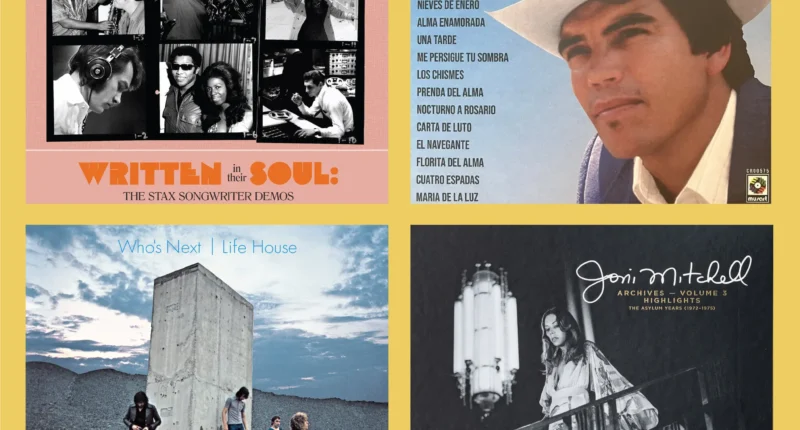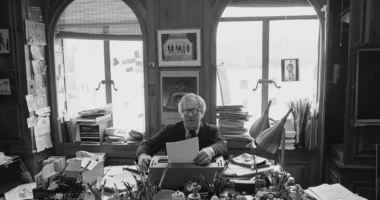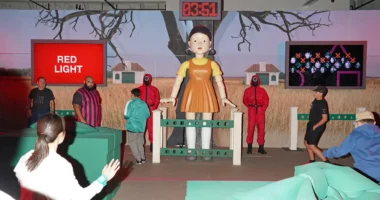Artists were eager to revisit the past in 2023 — some tweaking recent albums (like Taylor Swift), others revisiting long-dormant work in the vaults (like the two surviving Beatles). Boxed sets and reissue collections serve a different purpose, helping put catalogs and musicians into context, and bringing fresh revelations to light. Here are a dozen of the best our critics encountered this year.
Julee Cruise, ‘Floating Into the Night’
(Sacred Bones; one LP, $22)
The absorbing, unconventional debut album from the deep-exhale vocalist Julee Cruise, who died in 2022, was produced by Angelo Badalamenti and David Lynch; the three had previously collaborated on music for Lynch’s 1986 alt-noir film “Blue Velvet.” This batch of songs, released in 1989, plays as an extension of that fun-house mirror, lightly terrifying universe, with twisted 1950s melodies meeting destabilizing, plangent guitars meeting Dali-esque shimmers. “Falling” became the theme song for “Twin Peaks” in instrumental form, but its full vocal version is the essential one. Songs like that, “The Nightingale” and “Into the Night” feel, even now, sui generis — not exactly dream-pop or new age, but something utterly amniotic. And lightly harrowing, too. JON CARAMANICA
DeYarmond Edison, ‘Epoch’
(Jagjaguwar; five LPs, four CDs, 120-page book, $130)

Bon Iver didn’t come out of nowhere. Before he started that project, Justin Vernon was in DeYarmond Edison, a pensive, folky but exploratory band that made two albums before splitting up; other members formed Megafaun. DeYarmond Edison — Vernon’s middle names — delved into folk, rock, Minimalism and bluegrass, learning traditional songs but also experimenting with phase patterns. It made two studio albums and left behind other songs, including “Epoch.” This extensively annotated boxed set includes songs from Mount Vernon, DeYarmond Edison’s jammy predecessor, along with DeYarmond Edison’s full second studio album (though only part of its first), unreleased demos, intimate concerts, collaborations outside the band and Vernon’s 2006 solo recordings. It’s a chronicle that opens up the sources of a style getting forged. JON PARELES
Future, ‘Monster,’ ‘Beast Mode’ and ‘56 Nights’
(Epic; one LP each, $21.98)
During six months in the mid-2010s, the Atlanta hip-hop escapist Future remade himself during a daring and powerful three-mixtape run. He’d come into this stretch flirting with pop acclaim, but emerged something like a folk hero. There are some true hits on these releases, including the narcoleptic, charming “Codeine Crazy” and the ecstatic yelp “March Madness.” But lesser-heard songs like the howling “No Compadre,” the melancholic “Where I Came From” and the antic “Wesley Presley” are almost as effective. And Future’s sheer volume of recording, leaning on producers like Zaytoven and Southside, showed the versatility and relentlessness that still makes him a star almost a decade later. The quirky persistence of physical media — as decoration and historical codification and perhaps even as music delivery vehicle — means that mixtapes, when they’re important enough, end up getting hard-pressed into vinyl. So for the first time, these mixtapes (or slightly streamlined versions of them, alas) are officially available for physical collections, not just virtual ones. CARAMANICA
Sign up for The Amplifier newsletter, for Times subscribers only. Your alternative to the algorithm — a real, live human helps you discover songs you’ll love. Try it for 4 weeks.
Nanci Griffith, ‘Working in Corners’
(Craft Recordings; four CDs, $55; four LPs, $125)
Editors’ Picks
I Offered to Give My Home to My Son. Why Does He Expect Me to Leave It?‘The Color Purple’ Review: Still HereThe First Step to Get Off the Streets? A Room of His Own.

The Texas-born singer-songwriter Nanci Griffith, who died in 2021 at age 68, sometimes called her music “folkabilly” — a fitting description for a sound that blended reverent traditionalism with honky-tonk sweat. Though beloved by a devoted cult audience, Griffith mostly flew under the radar of the mainstream, so the recently released boxed set “Working in Corners” provides a welcome opportunity to reassess her legacy. Included here are Griffith’s first four albums, some of which have long been out of print, along with liner notes that put them in their proper context. Stretching from 1978, when Griffith was a budding folk revivalist with a penchant for sparse arrangements, to 1986, when she had blossomed into a confident country bandleader with a short-story-writer’s eye for evocative detail, “Working in Corners” charts the steady development of Griffith’s resounding talent. LINDSAY ZOLADZ
Whitney Houston, ‘I Go to the Rock: The Gospel Music of Whitney Houston’
(Gaither Music Group/Arista/Legacy Recordings; CD, $13.99; DVD, $19.99; both $29.95)
“Do you like gospel music?” Whitney Houston asked an audience at the Yokohama Arena in Japan in January 1990, before launching into an ecstatic six-minute medley of the devotional standards “He” and “I Believe.” This live recording is one of the six previously unreleased tracks featured on “I Go to the Rock,” a career-spanning compilation that centers Houston’s lifelong connection to gospel music. (A concurrently released DVD provides additional commentary.) The set features several familiar tracks from the 1996 soundtrack of “The Preacher’s Wife” — still the best-selling gospel album of all time — and two never-before-released performances from Houston’s 1995 “VH1 Honors” concert, including a rousing duet of “Bridge Over Troubled Water” with CeCe Winans. But the album’s most precious gem is “Testimony,” an upbeat, foot-stomping song Houston recorded in 1981, when she was just 17. Her voice, fascinatingly, was still unformed compared to the immaculate instrument she’d soon learn how to command, but, as ever, it was alive with passion and spirit. ZOLADZ
Joni Mitchell, ‘Archives, Vol. 3: The Asylum Years (1972-1975)’
(Rhino; five CDs, $69.98; four LPS, $99.98)
For Joni Mitchell, the period from 1972 and 1975 was a time of personal transformation and creative metamorphosis. The three exquisite, wildly different studio albums she released in that era — the solitary meditation “For the Roses,” the lively and openhearted “Court and Spark,” the searchingly experimental “Hissing of Summer Lawns” — tell the broad arc of the story, but this crucial and expansive boxed set fills in the details. Highlights include jam sessions with James Taylor and Neil Young (whose weeping guitar licks and harmonica turn the playful “You Turn Me On, I’m a Radio” into something else entirely); a crystalline 1972 Carnegie Hall show and a more rollicking 1974 set at the Dorothy Chandler Pavilion in Los Angeles; and early demos of future Mitchell classics like “Help Me,” “Lesson in Survival” and “The Jungle Line.” Across nearly six hours of chronologically arranged material, Mitchell’s music steadily cuts its own winding path from poetic folk toward pop-minded jazz, anticipating her late-70s work with Wayne Shorter, Jaco Pastorius and Charles Mingus. These years represent rapid growth, and this set provides an intimate look at Mitchell’s process — a rare opportunity to listen in as she perfects some of her most daring and enduring work. ZOLADZ
Chalino Sánchez, ‘15 Éxitos 15’
(Musart/Craft; two LPs, $50)
Chalino Sánchez was a singer of narcocorridos — tales of the drug trade — and also of deeply romantic and anguished ballads. He was killed in 1992 at age 31, and for all his success during his lifetime, death amplified his legend, ensuring that his elegantly sung songs and take-no-guff persona became a crucial part of the foundation for the Mexican and Mexican American music that arrived in his wake. In spirit, and sometimes in sound, Sánchez is one of the key precursors to the corridos tumbados movement that’s currently taking traditional Mexican music worldwide. This is the first time this anthology of songs recorded throughout his career — originally released in 1995, three years after Sánchez was killed — has appeared on vinyl, in an exclusive from Vinyl Me, Please. It is a blistering showcase of his wide and expressive voice, whether on the deeply sad “Nieves de Enero” and “Alma Enamorada,” or on the pride-filled tribute “A Todo Sinaloa.” CARAMANICA
Various Artists, ‘The Memphis Blues Box: Original Recordings First Released on 78s and 45s, 1914-1969’
(Bear Family; 20 CDs and 360-page hardcover book, $283)

This monumental collection — 534 well-chosen songs with an encyclopedic book — covers more than half a century of blues recorded in Memphis, with performers both well-known (B.B. King, Furry Lewis, Memphis Minnie, Elvis Presley, Ike and Tina Turner) and barely remembered. There were some constants through the decades: songs about loving, cheating, drinking, hard work and hard times. But the set also chronicles a genre solidifying and defining itself, as the variety of the 1920s and 1930s — with jug bands, string bands, jazz combos, barrelhouse piano, kazoos and clarinets — narrows into guitar-centered 12-bar shuffles and boogies, all sung with striking voices and wry resilience. PARELES
Various Artists, ‘Tribal Rites of the New Saturday Night: Brooklyn Disco 1974-5’
(Ace; one CD, $15; two LPs, $34)
Tony Manero would have never sashayed his way through Bay Ridge in “Saturday Night Fever” without the highly theatrical, occasionally lurid 1976 New York magazine article, written by Nik Cohn, about the emergent proto-disco nightclubs in Brooklyn. This compilation (which shares its name with that article) is an approximation of what was playing in those outer-borough rooms — highly sensual, up-tempo soul music pulsing with lustrous string sections and singing that blended ache with pride. “After You’ve Had Your Fling (Get Down to the Real Thing),” by the Intrepids, begins as a taunt and ends in a pool of ecstasy. “Wake Up Everybody,” by Harold Melvin & the Blue Notes, is dynamic but not quite explosive, regal but not quite rocking. In total, these songs capture a moment before the disco sound coalesced into something shimmery and a touch saccharine, underscoring its foundation as thrilling, swelling music to sweat to. (Brief excerpts from Cohn’s article are sprinkled throughout the liner notes, but a full reprint would have been welcome, even though the copy concedes the piece “was sold as fact but was fictional.”) CARAMANICA
Various Artists, ‘Written in Their Soul: The Stax Songwriter Demos’
(Craft; seven CDs, $90; digital download, $70)
Songs have to start somewhere. East/Memphis Music, the publishing arm of Stax Records, kept copies of hundreds of demos from the 1960s and 1970s: solo home recordings and tracks roughed out with Stax studio stalwarts, hi-fi and lo-fi, chosen to become singles or left on the shelf. This set gathers 146 of them: some that clearly mapped the finished versions, some that would be recast and some that hold tantalizing unrealized possibilities. It’s a chance to hear the voices of songwriters who largely stayed behind the scenes, like Bettye Crutcher, Homer Banks and Max Rice. It’s also a tribute to the Stax studio teamwork that would go on to punch up these demos into finished songs. PARELES
War, ‘The World Is a Ghetto: 50th Anniversary Collector’s Edition — The Complete Sessions’
(Rhino; five LPs, $125)
The long-running Los Angeles band War came up with hybrid grooves — funk-Latin-blues-rock-gospel-reggae-soul — that sounded as casual as block-party jam sessions. But they weren’t. War’s 1972 album, “The World Is a Ghetto,” went to No. 1 with hits built on those grooves, including “Low Rider” and “The Cisco Kid.” The expanded reissue includes an LP of outtakes and, for each of its six songs, a 25-minute montage of session material. The songs take shape as the band chooses sounds, toys with riffs and rhythms, reworks lyrics and tightens up every syncopation; they’re jovial, but they’re doing the work. PARELES
The Who, ‘Who’s Next/Life House’
(Geffen; 10 CDs, 1 Blu-ray audio, 100-page hardcover book, $300)
Pete Townshend had vast ambitions for the Who’s studio follow-up to the rock opera “Tommy,” but cooler heads prevailed and it was cut back to a concept-free single album: “Who’s Next,” a pinnacle of the band’s career. In 1970, long before the internet, Townshend envisioned “Life House” as a high-tech parable about ecological disaster, tyranny, virtual entertainment and the healing communal power of live rock music, which he wanted to generate with crowdsourced information from concert workshops. He also leaped into early synthesizer technology. Townshend never quite let go of “Life House”; he has released parts of it on solo collections, and this year he also collaborated on turning its story into a graphic novel. This exhaustive boxed set unites “Who’s Next” with the whole painstaking process before it: demos, instrumentals, discarded songs with elements that would resurface elsewhere, variations and ferocious live workshop concerts at small theaters, along with spatialized Blu-ray remixes. It’s a deep dive into Townshend’s intense, convoluted creative efforts. The extended instrumental versions of the electronics-driven “Baba O’Riley” are spectacular; so is the live, muscular and metaphysical “Time Is Passing.” PARELES






